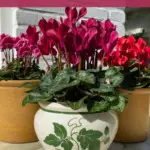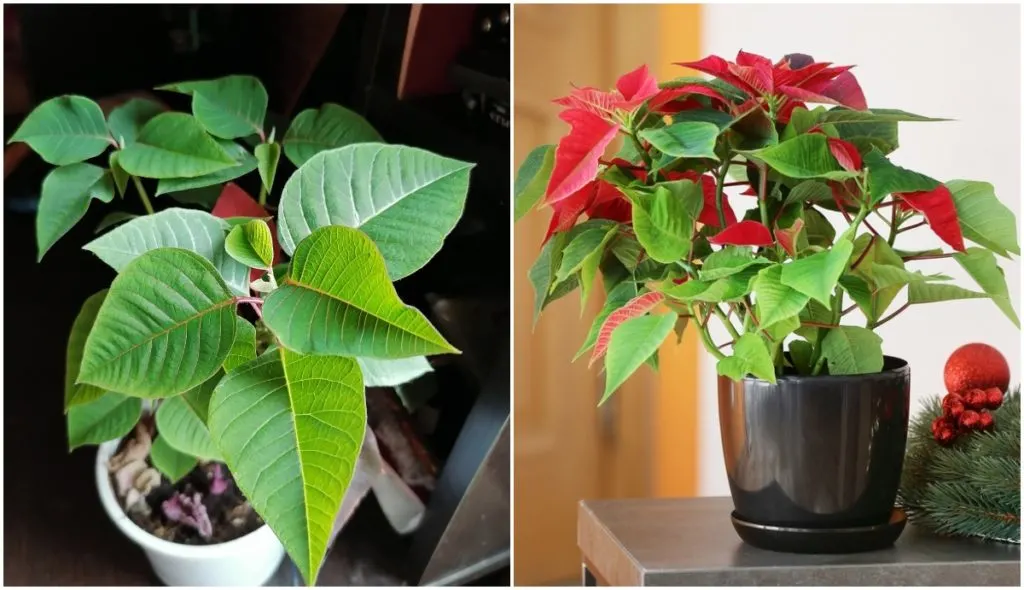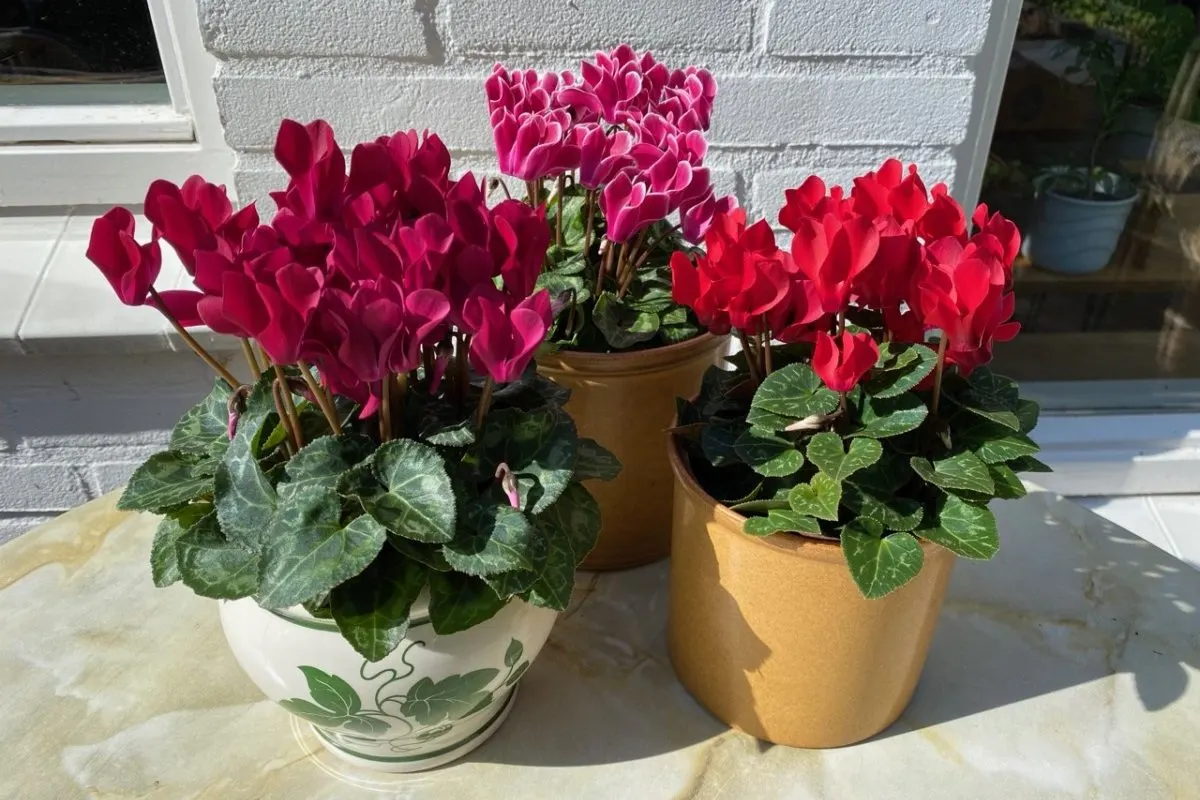
My first memory of cyclamen is tied to browsing through mail-order furniture catalogs as a pre-teen. I was more interested in the decorative houseplants than in the furniture. These weirdly-shaped plants seemed one of four styling choices, along with peace lilies, snake plants and spider plants. I don’t remember how I got into such browsing pursuits, but this was pre-internet, and an introverted child had to keep herself occupied somehow.
Perhaps this is why I still consider cyclamen plants to have a nostalgic look and a retro feel to them.
As an adult, I’ve been bringing cyclamen into my home around late fall and early winter for years. I like to place a few pots around the house. Their cheerful blooms brighten up the cold and gray winter days.
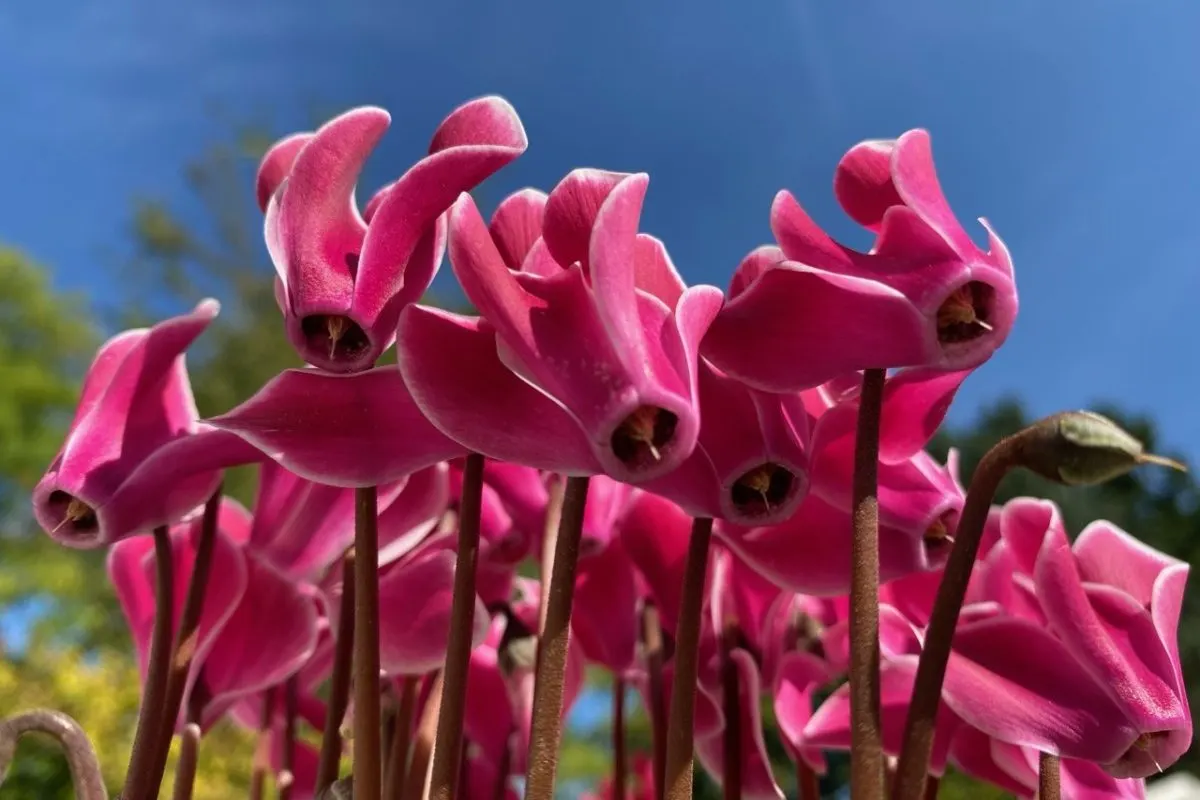
If you’ve noticed cyclamen for sale at your local plant store or supermarket around this time of year – buy some.
These plants have a reputation for being fussy. Let me assure you; they’re quite easy to care for.
There are about twenty-three species of cyclamen with different bloom times. However, the ones that reliably bloom in late fall, winter and early spring are called Cyclamen persicum. You will also find them labeled as florist’s cyclamen or Persian cyclamen. This is the type of cyclamen that you’re likely to find for sale as a houseplant in the winter.
Cyclamen persicum itself has a lot of cultivars in different shades of red, fuchsia, peach, magenta, white and cream.
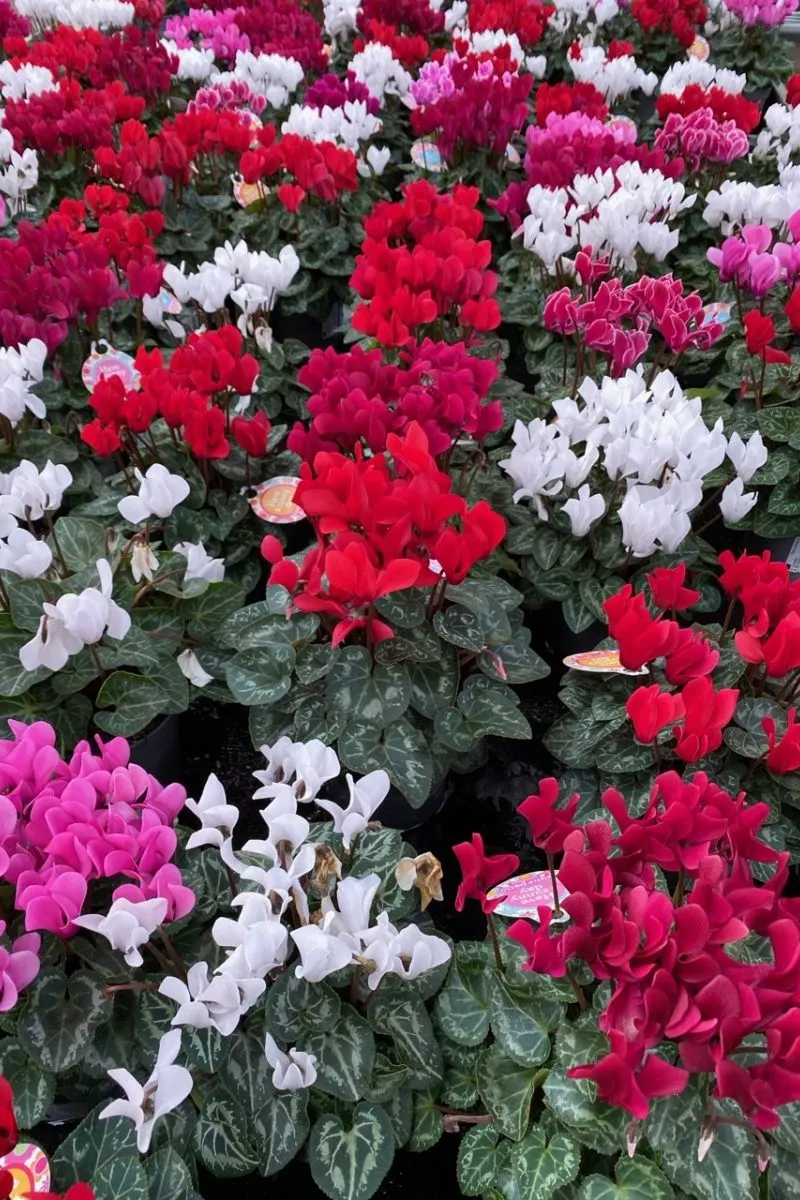
In its natural habitat, which spans from Greece to Turkey, Lebanon, Algeria and Tunisia, the Persian cyclamen is a herbaceous perennial with a mounded growth habit. It grows on rocky slopes and as undergrowth in pine forests and oak thickets. It blooms from early winter to early spring. In the summer, it goes into a period of dormancy to survive the hot, dry temperatures of the Mediterranean.
Its variegated heart-shaped leaves and sweet-scented colorful flowers have made cyclamen a popular greenhouse plant since the 1800s in Europe.
The florist’s cyclamen is frost tender (and winter hardy only in USDA zones 9-11). This is why you’re more likely to find it grown indoors.
How to Care for Cyclamen Indoors
There are two tips for keeping Persian cyclamen happy indoors:
1. Persian cyclamen like low temperatures.
The first tip to keep cyclamen as houseplants is maintaining their preferred temperature while they’re in bloom. In the wild, cyclamen grow in the shade. It prefers environments that are cool and humid during the winter but not freezing. Ideally, you want to replicate these conditions indoors as much as possible. So place your pot of cyclamen in bright but indirect light.
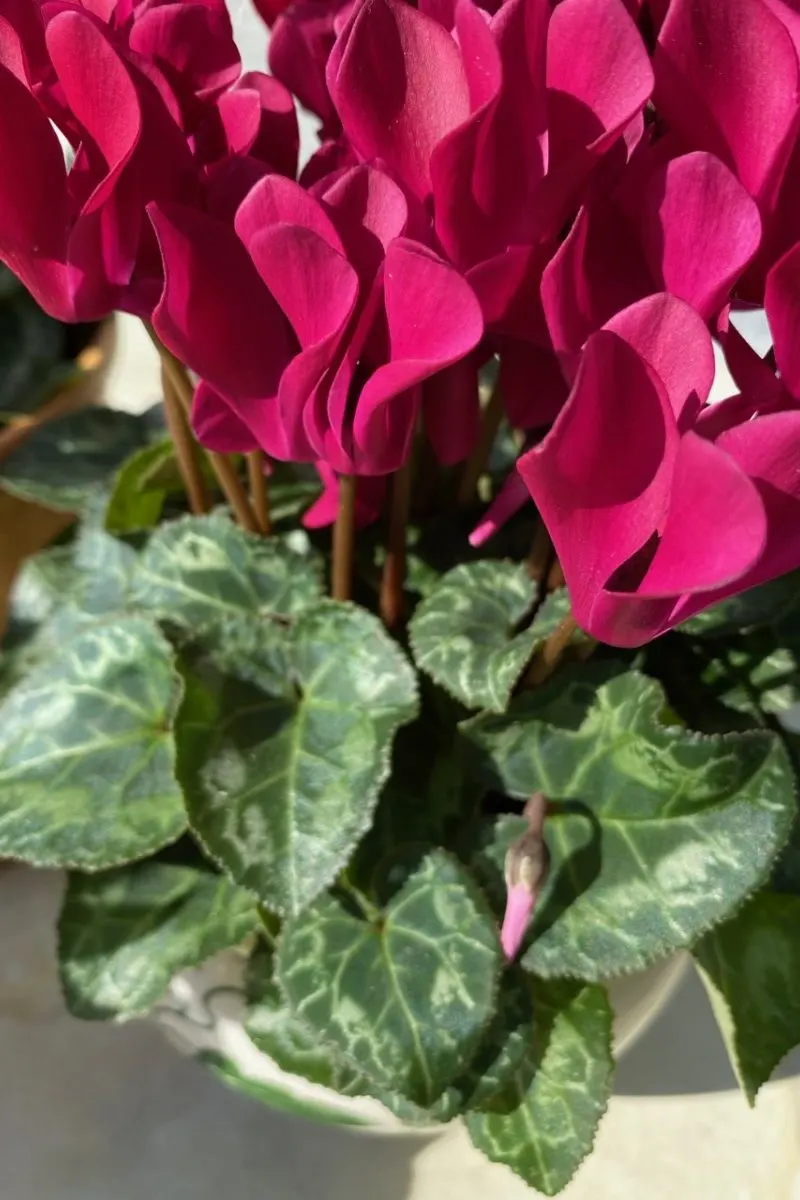
Your cyclamen will thrive in a humid location, such as your bathroom or your kitchen. Choose a spot that doesn’t get above 68F (around 20 C) during day time. At night, the temperature can drop as low as 50F (around 10C), and your cyclamen will still be happy.
For the same reason, keep your cyclamen away from radiators, fireplaces, stoves or heat vents.
If it gets too warm, the blooms will wilt prematurely, and the leaves will start to turn yellow. Once that process starts, you can’t reverse it, unfortunately. If you’re unlucky and the entire plant dies back, dig out the tubers. Keep them in a cool, dry place and plant them again early next fall (more about that later).
Don’t overdo the chill, though. Florist’s cyclamen don’t do well in temperatures that drop below 40F (around 4.5C.)
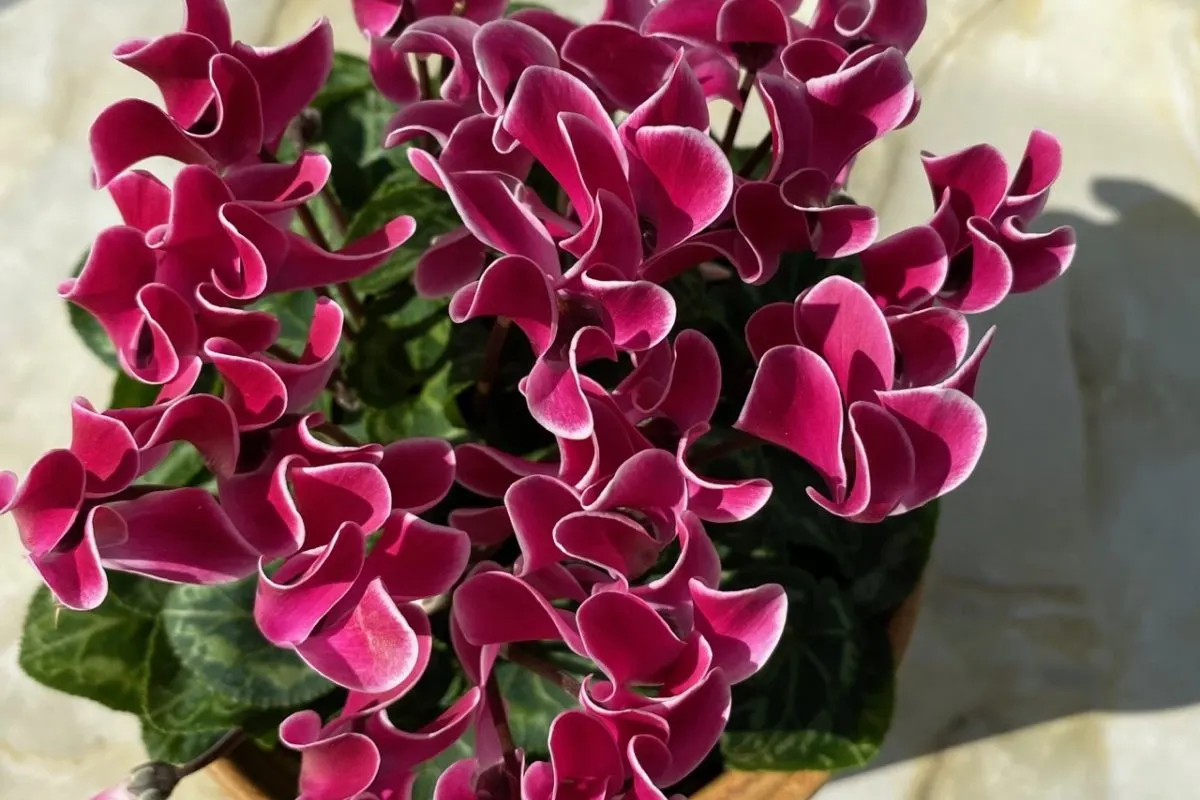
2. Persian cyclamen can’t handle too much water.
Like any plant grown from tubers, cyclamen doesn’t like to have its “feet” wet. One of the biggest mistakes that you can make while caring for your cyclamen is overwatering it.
Sometimes, others will make that mistake for you, unfortunately. I’ve experienced buying cyclamen that had been overwatered in the store and collapsed into a mushy pile once home. Stores mishandle plants more often than you think (they’re notoriously bad with poinsettias).
Check the soil of the plant before you bring it home. If it’s soggy wet, you’re better off looking elsewhere.
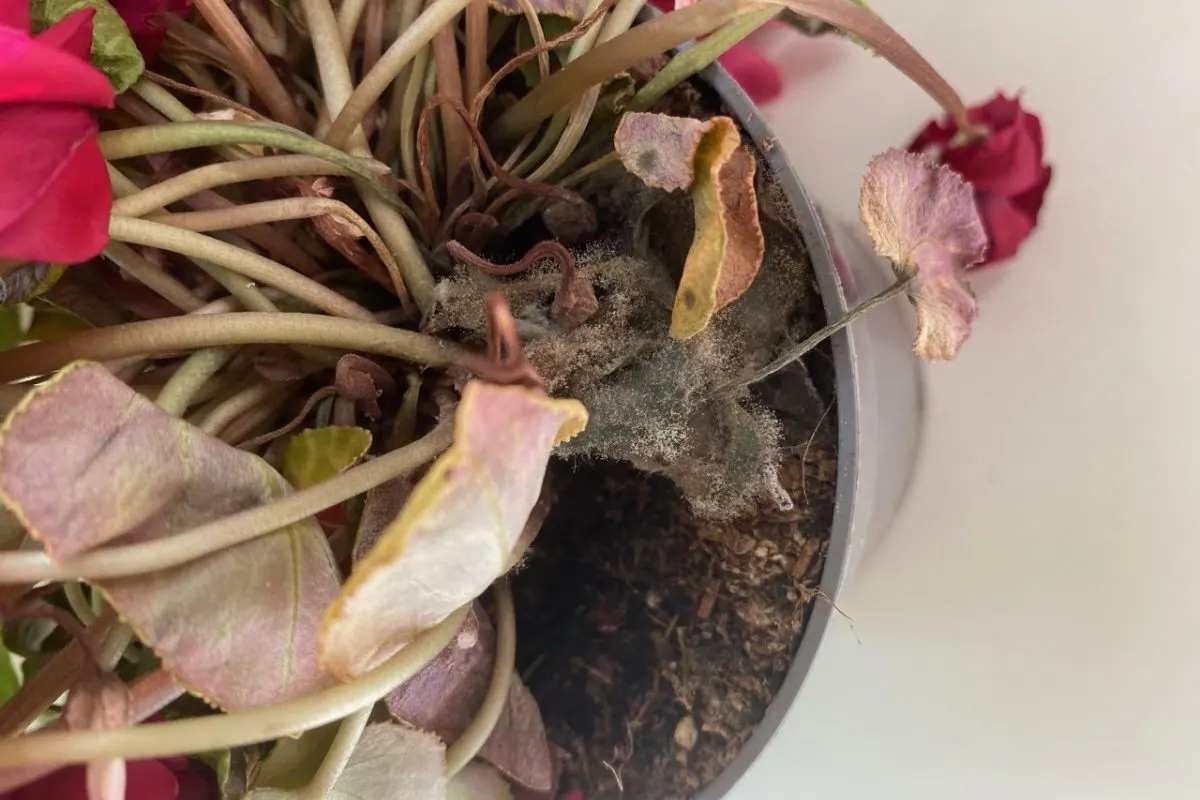
All nursery pots have drainage holes, so if you leave your cyclamen in place, you’re covered. If you use cyclamen to create a winter display or centerpiece for Christmas dinner, replant your cyclamen in containers with drainage holes.
Cyclamen will tell you when it needs more water by drooping its flowers and leaves. Underwatering is just as bad as overwatering it. It’s not a good idea to let it yo-yo between too dry and too wet. Water your plant along the edge of the pot, avoiding the tuber when the soil feels dry to the touch.
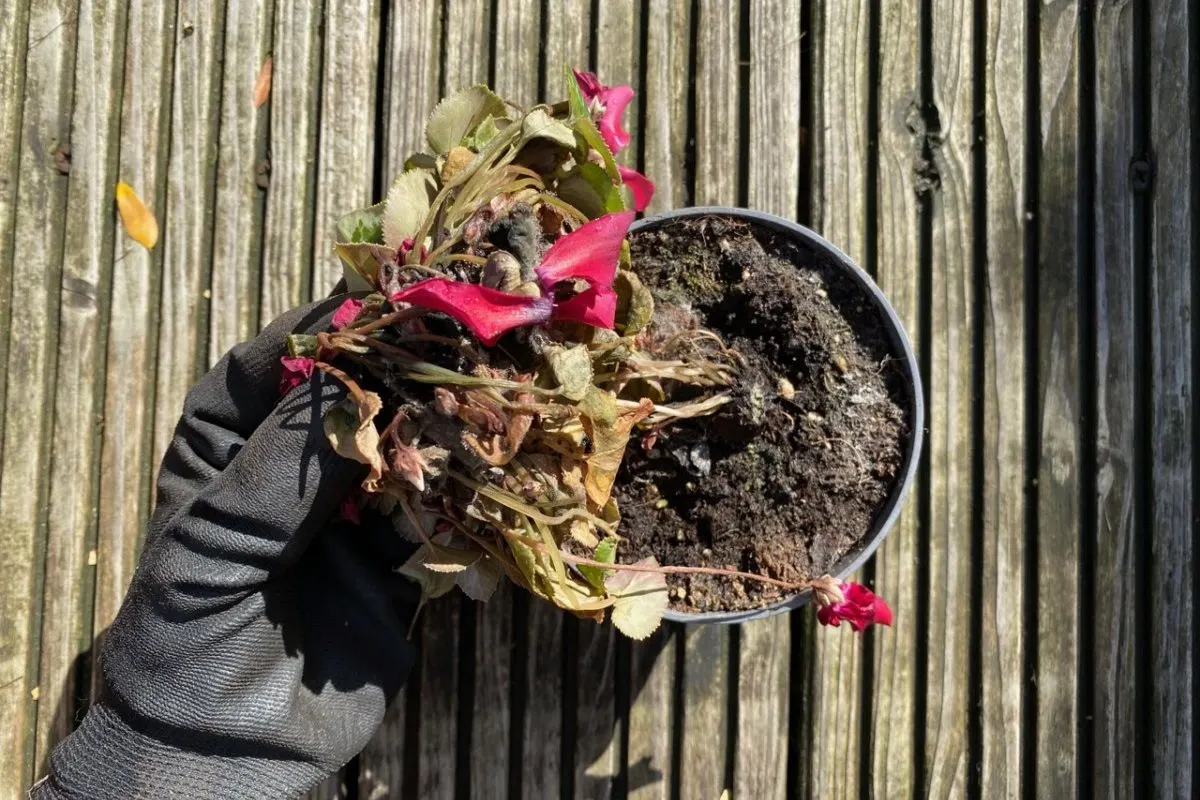
Never water above the crown, and avoid getting the leaves wet. Instead, gently lift the leaves and pour the water straight on the surface of the soil. The best practice is to water by soaking. Set the pot in a shallow dish of water for a few minutes. Then remove it and let it drain before putting it back.
What should I do with cyclamen after flowering?
Typically, indoor cyclamen will stay in bloom for about a month. Sometimes, they can bloom for five or six weeks under the right conditions.
After the final blooms are gone, the foliage is next, with the leaves turning yellow and falling almost overnight. This doesn’t mean the plant is dying but going into its dormancy period. In its natural habitat, it needed to retreat underground in order to survive hot, dry Mediterranean summers.
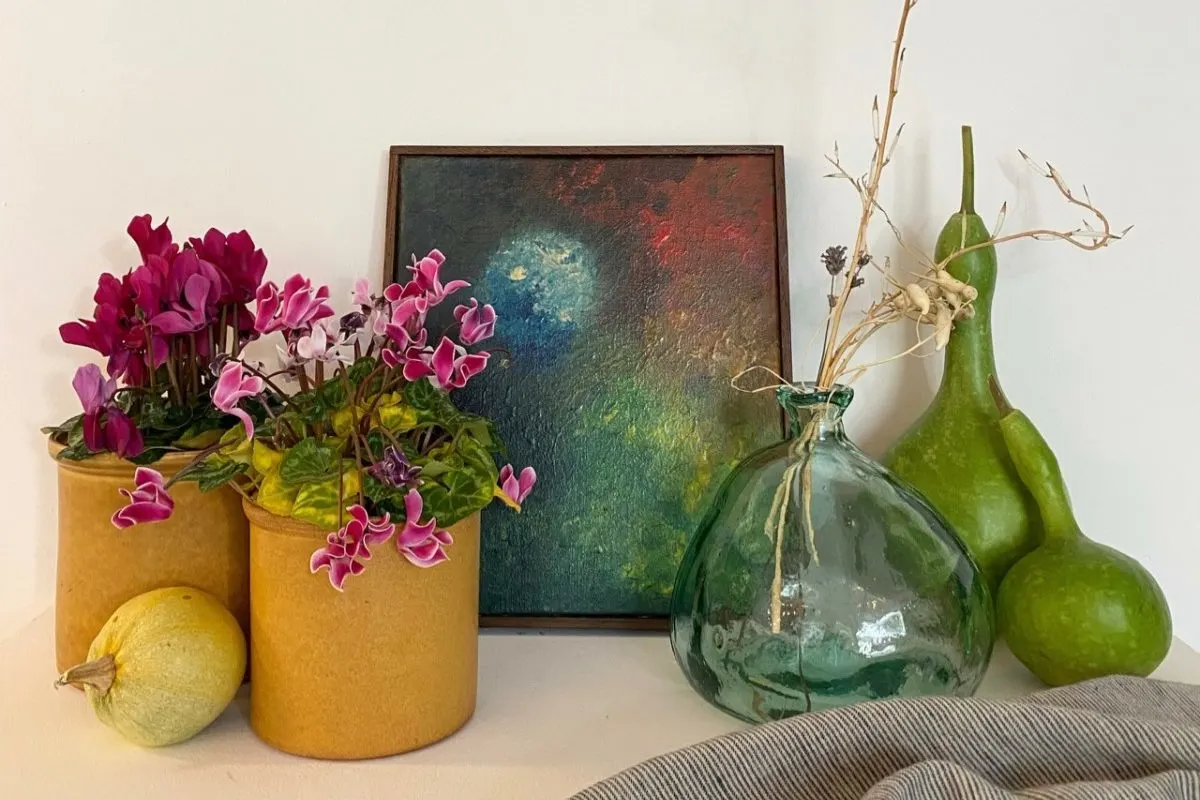
At this point, you should stop watering the plant and allow dormancy to set in. (Truth be told, there’s not much left to water anyway.) Dig out the tuber, put it in a paper bag and place it in a cool, dry and dark location. Or leave the tubers in the pot, and place it in a cool, dark room, such as a pantry or a garage.
This is where it will spend the rest of the summer.
I prefer to “over-summer” cyclamen in its pot because I’m less likely to forget to replant it in the fall. Since it looks like a pot full of dirt, remember to add a label that says, “I’m not dead; I’m just dormant.” Guaranteed the rest of your family won’t throw it away if they get in on the joke.
Every now and then, you can water the pot very lightly to ensure it doesn’t get bone dry.
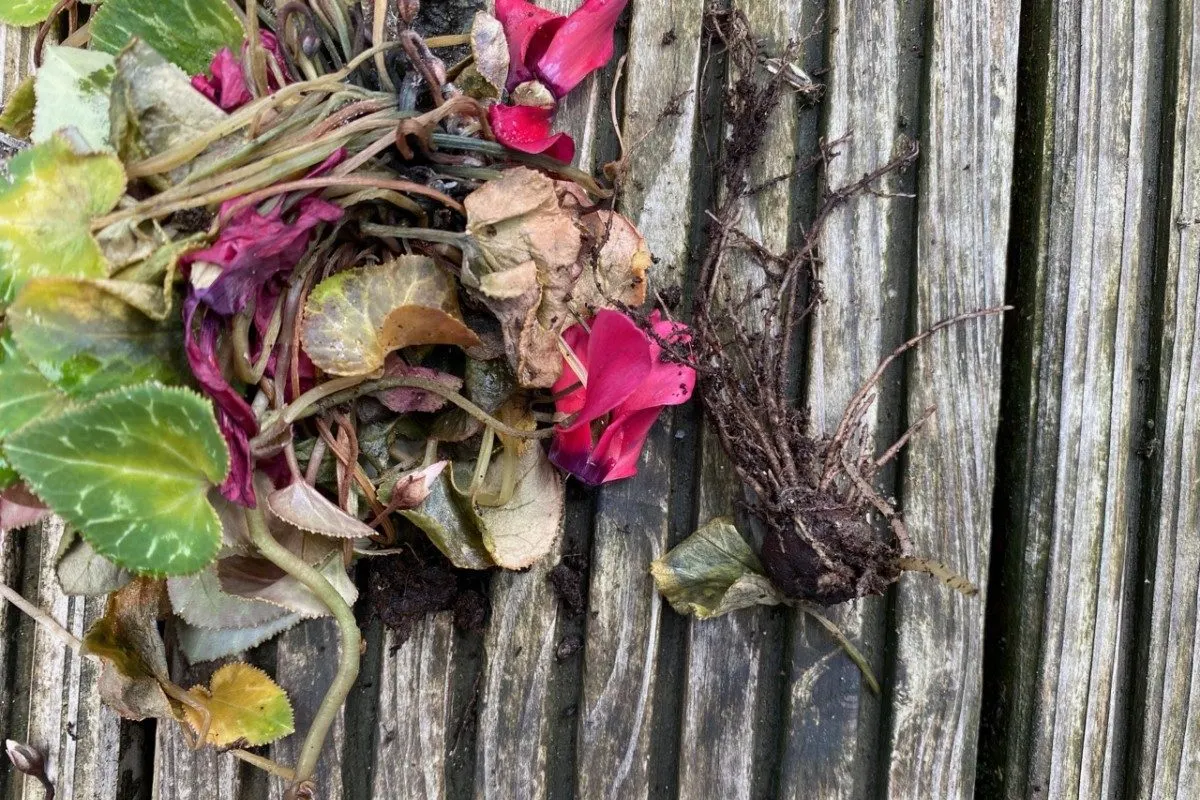
Around September, you’ll start seeing tiny leaves poking out. This telltale sign means your cyclamen is waking from its slumber. Bring it out of storage and start watering it again – lightly at first and more as the leaves start growing.
Always make sure that the excess water drains away.
Once the leaves reach their full size, the blooms should follow by early winter. Set it in a spot with bright indirect light and continue to care for it as you did when you first brought it home.
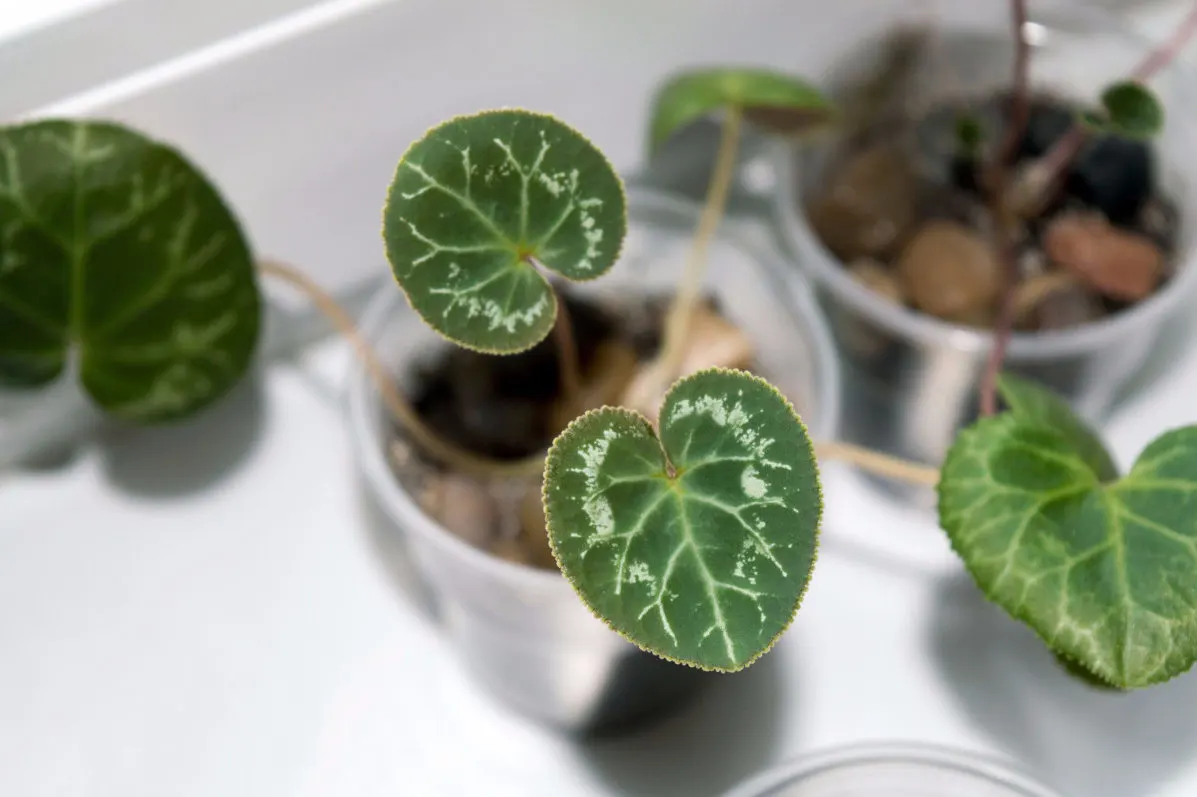
To avoid disappointment, I think it’s worth mentioning your plant might not rebloom as profusely the second or third time around. As a perennial with an unusual dormancy period, its second bloom might be a bit more subdued. It will be less compact, with fewer and spindlier blooms. This is one of the reasons why some treat it as an annual and buy a new one every year.

Can I keep my cyclamen plant outdoors?
If you live in a gardening zone that doesn’t get any frost, you can keep Cyclamen persicum outdoors in the fall and winter .
Its colorful bulbs are often used in fall outdoor arrangements such as window boxes, harvest baskets and vintage urns.
Remember, this type of cyclamen is not frost-hardy and cannot be planted in the ground in most climates.
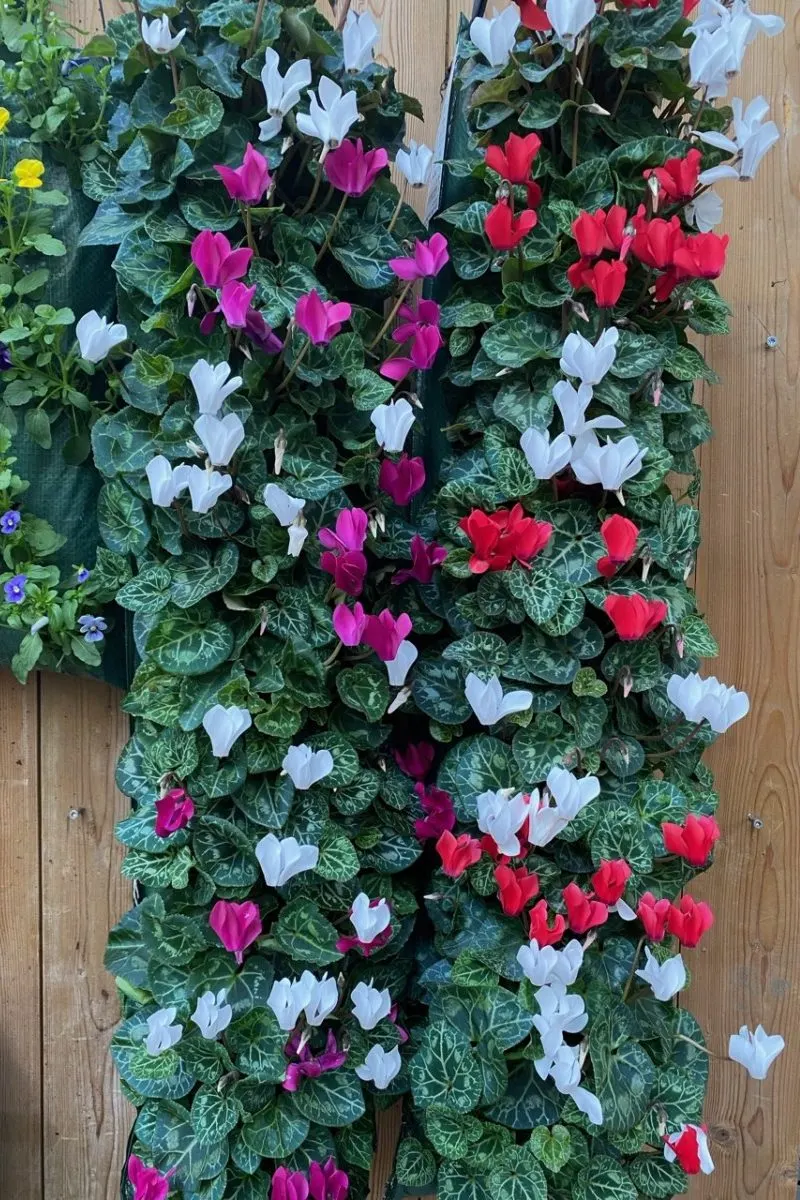
But there is a solution if you want to grow cyclamen in your garden: grow a different type. Cyclamen hederifolium (also known as the ivy-leaved cyclamen) has the same characteristics and growth pattern as the florist’s cyclamen.
It grows from a tuber that sprouts leaves in the fall, flowers during the winter and goes dormant in the summer. However, the ivy-leaved cyclamen is winter hardy and can withstand temperatures below freezing.
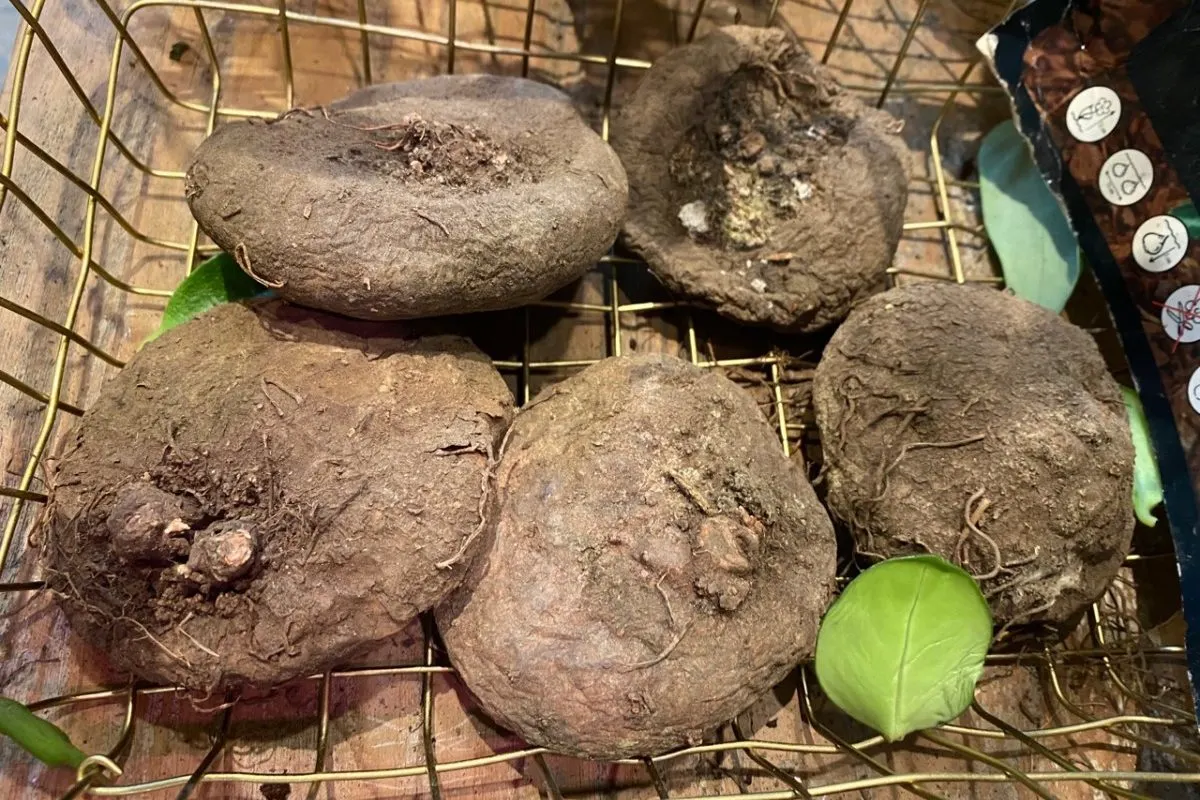
A full-shade spot in your garden where not much else grows is the best spot for your Ivy-leaved cyclamen tuber.
It will thrive under trees and shrubs as long as they’re deciduous and can get some light in the winter when it’s in bloom. The other nice thing about this tuber is that it can grow very well in poor soil. (No wonder, since in the wild, it grows in rock crevices.)
Like all plants that grow from bulbs and tubers, cyclamen will do well in well-drained soil that doesn’t stay waterlogged.
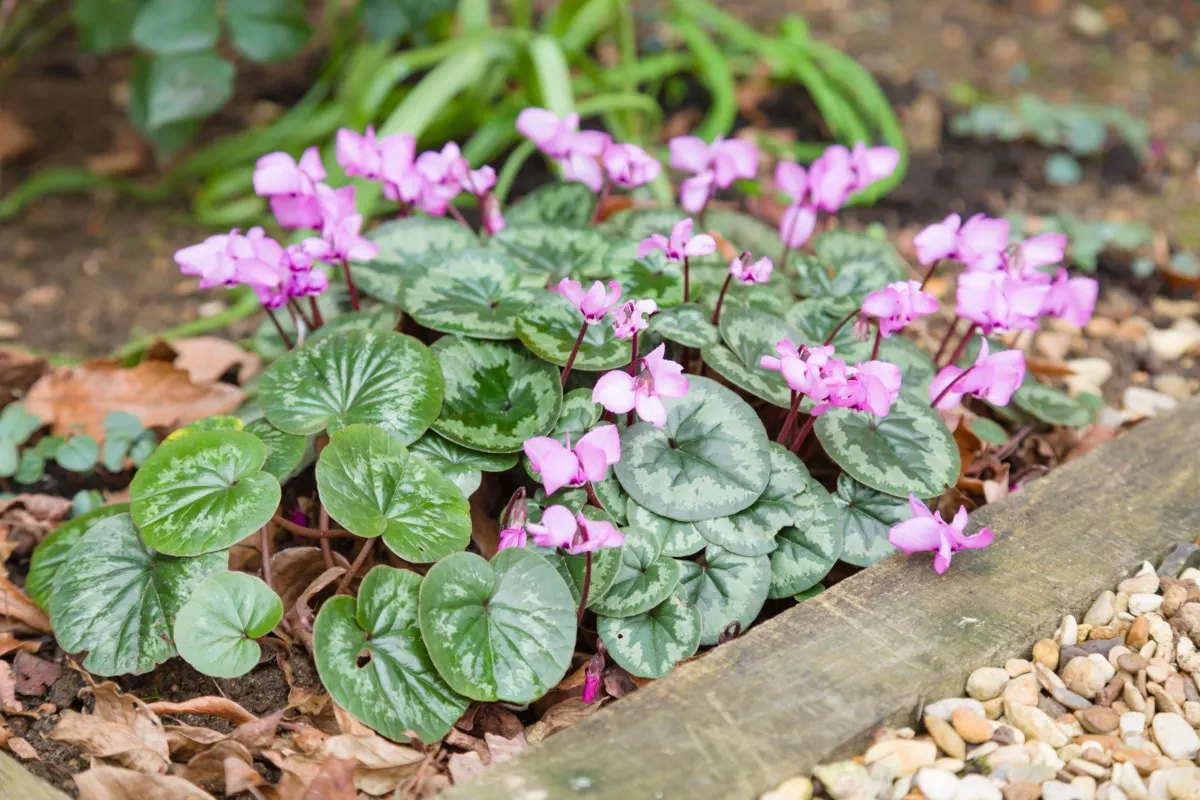
The best time to plant Cyclamen hederifolium tubers is in the fall when you plant your other bulbs. However, don’t bury the tubers as deep. Place them just below ground level and cover them with a thin layer of soil.
Don’t expect it to bloom the first year, though, since it will need some time to get established.
Just like its cousin, Cyclamen persicum, this one will also go through a dormancy period in the summer. But it doesn’t need any assistance from the gardener, like its houseplant counterpart. Allow the soil around the tubers to dry in the summer. Start watering again in September if you’re not getting much rain.
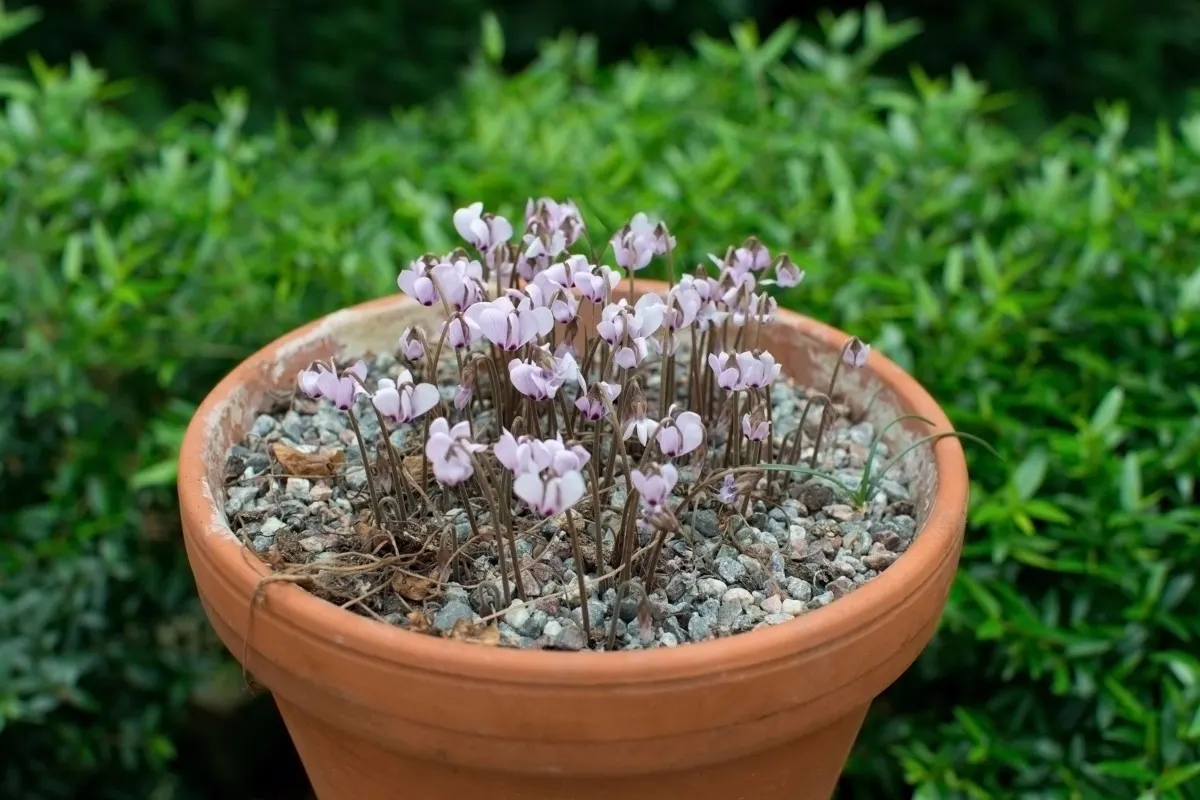
Unfortunately, the cyclamen plant doesn’t propagate via tuber division but via seeds. And seed germination is not only unreliable but very slow. It can take up to a year or more for a seed to turn into a plant. This is how commercial growers propagate cyclamen plants, but it’s hard to replicate their controlled greenhouse conditions at home.
Even if your cyclamen isn’t a reliable bloomer, buying a few to brighten up the home around the holidays is well worth it.
Read Next:

Get the famous Rural Sprout newsletter delivered to your inbox.
Including Sunday musings from our editor, Tracey, as well as “What’s Up Wednesday” our roundup of what’s in season and new article updates and alerts.


